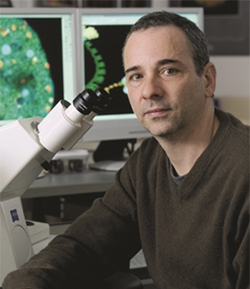Andre Nussenzweig, PhD
NIH Distinguished Investigator
Laboratory of Genome Integrity
 My laboratory is focused on understanding the mechanisms that maintain genomic stability. Central to a cell's ability to maintain genomic stability are systems that monitor and repair DNA single and double strand breaks. These breaks occur during normal physiological processes such as antigen receptor rearrangements in lymphocytes, DNA replication and meiotic recombination. However, the inactivation of DNA repair pathways, the action of exogenous agents such as carcinogens and even baseline DNA damage by endogenous processes can overwhelm functional DNA repair machineries to generate a diversity of somatic mutations that is then reflected as mutational signatures associated with a broad spectrum of cancers.
My laboratory is focused on understanding the mechanisms that maintain genomic stability. Central to a cell's ability to maintain genomic stability are systems that monitor and repair DNA single and double strand breaks. These breaks occur during normal physiological processes such as antigen receptor rearrangements in lymphocytes, DNA replication and meiotic recombination. However, the inactivation of DNA repair pathways, the action of exogenous agents such as carcinogens and even baseline DNA damage by endogenous processes can overwhelm functional DNA repair machineries to generate a diversity of somatic mutations that is then reflected as mutational signatures associated with a broad spectrum of cancers.
Over the years, my laboratory has elucidated many fundamental features of DNA damage and repair proteins and revealed the critical role they play in both normal and pathogenic states. These studies have emphasized the importance of DNA repair pathway selection as contributors to chemoresistance or sensitivity in breast and ovarian cancers and specific hematological malignancies. Relatedly, our efforts have linked the stabilization of the DNA replication fork as an alternate and important route to chemoresistance. Separately, our observations regarding the RECQ helicase WRN helped reveal the myriad ways that tumor cells acquire drug resistance and concurrently identified numerous new vulnerabilities that can be targeted.
We have been at the leading-edge of developing genomic technologies to monitor DNA damage. In this regard, we have described a sensitive method (END-seq) to monitor DNA double strand breaks globally at base-pair resolution in vivo. This has led to the identification of new classes of fragile sites which reside at conserved topological domain borders. These studies provided insight into mechanisms by which the pre-existing three-dimensional folding of chromosomes could be co-opted in cancer. These new genomic approaches have also helped identify the expansion of repetitive DNA elements as a source of genome instability and led to the discovery of hotspots of endogenous DNA damage in neurons. Recently developed genomic approaches (SAR-seq - Synthesis Associated with Repair sequencing and S1-END-seq revealed hotspots of DNA repair in the neuronal genome. These data provided the first evidence of site- and cell-type-specific single strand break repair, and an explanation for the neurodegenerative phenotypes that occur in patients with defective single strand break repair.
Overall, the goal of my program is to use hypothesis-driven approaches to develop therapeutic strategies in the treatment of cancers and other disease states such as leukemias and neurodevelopmental disorders. Over the last few years, my laboratory has mentored many graduate students who represented international institutions such as Oxford, Cambridge, the University of Madrid as well as national graduate programs that included students from the NIH University of Pennsylvania-Immunology Graduate Group.
My PubMed Summary: https://pubmed.ncbi.nlm.nih.gov/?term=Nussenzweig%20A


